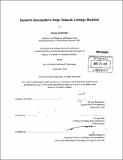Dynamic descriptions : steps towards a design machine
Author(s)
Toulkeridou, Varvara
DownloadFull printable version (8.489Mb)
Other Contributors
Massachusetts Institute of Technology. Dept. of Architecture.
Advisor
George Stiny.
Terms of use
Metadata
Show full item recordAbstract
This thesis questions which would be a valid approach for building design machine aided by computational intelligence capable of generating surprises for their designers-observers. There have been efforts since the 1960s towards developing frameworks for design machines that were envisioning computational systems as something more than tools for efficient production and representation. Some of them were dealing with design problems as complex systems that needed to be broken down in modular parts, for example Christopher Alexander's "Notes on the Synthesis of Form". However such strategies were associated with explicit languages of descriptions and strong hierarchies, defined in advance by the designer, that were constraining the design space to what these predefined descriptions were anticipating. This thesis draws its motivation from the work of Professor of Design and Computation George Stiny on visual computations operating on non-fixed sets of primitives, as well as from research conducted in the field of Artificial Intelligence on alternative representations. I will propose a framework for a design machine highlighting the importance of it being able to generate its own dynamic descriptions, "entities" that bear content independent of the interpretations of their designers. Inspired by a computational system, developed by Stephen Larson (2003), capable of grounding its own symbols in perception, I will experiment with self-organizing map algorithms suggesting them as a possible way for a design machine to build up and update its language of description from its perceptual information.
Description
Thesis (S.M.)--Massachusetts Institute of Technology, Dept. of Architecture, 2010. Cataloged from PDF version of thesis. Includes bibliographical references (p. 59-61).
Date issued
2010Department
Massachusetts Institute of Technology. Department of ArchitecturePublisher
Massachusetts Institute of Technology
Keywords
Architecture.